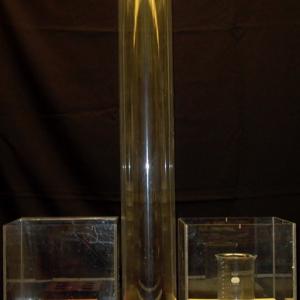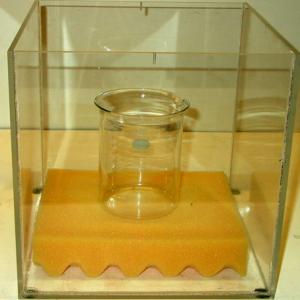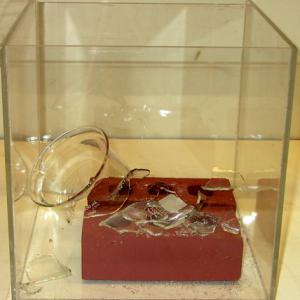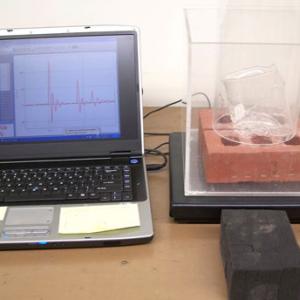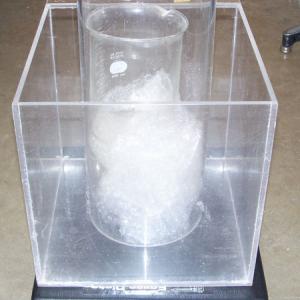College of Liberal Arts & Sciences
1N10.30 - Impulse Demo - Dropping Beaker/Eggs
Set the plastic tube inside the first box and on top of the foam. Drop the beaker inside the tub and observe that it does not break due to the long stopping time (impulse). Move the tube over to the second box and on top of the bricks. Drop the beaker down the tube and observe that the short stopping time (impulse) breaks the beaker.
You can also do this experiment and record the impulse data using the Vernier Force Plate and the Vernier interface. Place the Plexiglas box onto the force plate. Put two pieces of wadded up bubble wrap from the box of bubble wrap used for this demo into the end of the Plexiglas tube and set it upright in the box. The force plate should be on the - 200/850 Newton setting. Tare the force plate. Start your data collection and drop the beaker into the tube. Then take the bubble wrap and the beaker out of the tube and the box. Next place the box onto the force plate, place the bricks into the box and balance the tube on top of them. Tare the force plate and repeat the data collection when you drop the beaker. Compare the two graphs and in particular notice the difference in the time duration of the two collisions.
- Nathaniel R. Greene, Tom Gill, Stephen Eyerly, "Finding the Effective Mass and Spring Constant of a Force Probe from Simple Harmonic Motion", TPT, Vol. 54, #3, Mar. 2016, p. 138.
- Lila M. Adair and Garry C. Loveless, "Walking on Eggs", TPT, Vol. 35, #1, Jan. 1997, p. 28.
- Mark A. Ilyes, "The Haystack or the Brick Wall?", TPT, Vol. 34, #4, Apr. 1996, p. 254.
- Tom Senior and James Szeszol, "Impulsive Break Point", TPT, Vol. 27, #5, May 1989, p. 394.
- T. T. Grove and A. Ehle, "Impulse, Momentum, and Energy of Human Strikes Using Inexpensive Piezo Disks", AJP, Vol. 72, #2, Feb. 2004, p. 281.
- Fred Jeffers and Jack A. Soules, "Elementary Study of Impulsive Forces", AJP, Vol. 33, #12, Dec. 1965, p. 1079.
- Martin Gardner, "Matchbox Stabilizer", Entertaining Science Experiments with Everyday Objects, p. 97.
- Vicki Cobb and Kathy Darling, "No Shattering Experience", Bet You Can't!, p. 42.
- "Egg and Sheet", Physics From the Junk Drawer, 3rd Edition, The Science House, North Carolina State University, p. 16.
- Robert Ehrlich, "A.5. Dropping an Accelerometer from Various Heights", Turning the World Inside Out and 174 Other Simple Physics Demonstrations, p. 12.
- Julius Sumner Miller, Q121 & A121, Millergrams II – Some More Enchanting Questions for Enquiring Minds, p. 15 & 78.
- Julius Sumner Miller, Q135 & A135, Millergrams II – Some More Enchanting Questions for Enquiring Minds, p. 22 & 83.
Disclaimer: These demonstrations are provided only for illustrative use by persons affiliated with The University of Iowa and only under the direction of a trained instructor or physicist. The University of Iowa is not responsible for demonstrations performed by those using their own equipment or who choose to use this reference material for their own purpose. The demonstrations included here are within the public domain and can be found in materials contained in libraries, bookstores, and through electronic sources. Performing all or any portion of any of these demonstrations, with or without revisions not depicted here entails inherent risks. These risks include, without limitation, bodily injury (and possibly death), including risks to health that may be temporary or permanent and that may exacerbate a pre-existing medical condition; and property loss or damage. Anyone performing any part of these demonstrations, even with revisions, knowingly and voluntarily assumes all risks associated with them.
